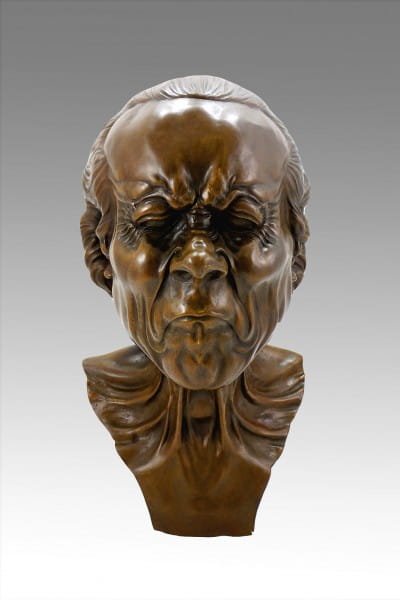Prices incl. VAT, free shipping worldwide
Ready to ship today,
Delivery time appr. 3-6 workdays










Product description
"Franz Xaver Messerschmidt - Character Head - Bronze figure"
| Height | 35 cm |
| Width | 22 cm |
| Length | 23 cm |
| Weight | 4 kg |
A Face Beyond Recognition - Character Head – Bronze Bust - Signed Xaver Messerschmidt
The Character Head presented here in bronze is a striking example of the emotional and muscular intensity characteristic of the series. The face is not passive, idealized, or serene. Instead, it appears caught in a moment of extreme sensation: perhaps pain, pressure, disgust, or suppression. The eyes may be closed in fierce resistance, or narrowed in judgment. The mouth is pulled taut, revealing inner tension that transforms flesh into topography. What makes these Franz Xaver Messerschmidt Art Works so unforgettable is that they are not psychological portraits in the modern sense, but visual manifestations of interior states—momentary conditions immortalized in bronze.
The Sculptor Who Challenged the Enlightenment from Within
Franz Xaver Messerschmidt was born on February 6, 1736, in the small German town of Wiesensteig in the Swabian Alps. Trained at the Academy of Fine Arts in Vienna, he quickly rose to prominence with refined, neoclassical portrait busts commissioned by members of the Habsburg court. Early Franz Xaver Messerschmidt Art Works aligned with Enlightenment ideals: clarity, proportion, and noble restraint. But beneath the surface of academic perfection stirred a deeper and darker impulse—an artistic obsession that would ultimately isolate him from the institutions that first celebrated him. Over time, his style grew more experimental, and his desire for inner truth outweighed the need for social or artistic approval.
Pressburg and the Birth of a Revolutionary Series
After tensions with colleagues and possible symptoms of mental and physical illness, Messerschmidt left Vienna around 1774 and retreated to the city of Pressburg (now Bratislava). It was there, in seclusion and outside the reach of academic oversight, that he began his most extraordinary body of work: a series of over 52 sculptural busts known today as the Character Heads. These are not typical portraits. They are extreme facial studies—each one capturing a specific, often grotesquely distorted expression. The Character Heads are the foundation of the most celebrated Franz Xaver Messerschmidt Sculptures, and they remain among the most enigmatic and influential creations in the history of European sculpture.
Bronze That Feels Like Skin and Muscle
Unlike the cool elegance of his early marble commissions, this bronze bust feels alive with pressure and presence. The surface is smooth, yet not sterile. Light reveals the tension in the cheeks, the sharp edges of frowning lines, the bulging neck muscles. The head has weight and density, but it also seems to vibrate with nervous intensity. As with many Franz Xaver Messerschmidt Sculptures, the physical material reflects both anatomical knowledge and emotional urgency. Bronze becomes more than medium—it becomes meaning.
The Character Heads as a Visual Language
What separates the Character Heads from other expressive artworks of their time is their systematic exploration of facial expression. According to anecdotes, Messerschmidt believed he was tormented by a "spirit of proportion" that attacked him nightly. In response, he began to document his own facial contractions, observing them in a mirror and sculpting them from memory. Whether understood as a proto-psychological project, a mystical defense mechanism, or a brilliant artistic experiment, the results are without precedent. Each bust stands alone, yet together they form an obsessive, wordless language of emotion and sensation—a visual vocabulary composed entirely of flesh.
A Legacy of Ambiguity and Influence
At the time of their creation, the Character Heads were misunderstood, even ridiculed. They did not conform to the ideals of noble portraiture or heroic depiction. Yet centuries later, they resonate more strongly than ever. Artists from the expressionists to the surrealists have looked to Franz Xaver Messerschmidt as a forerunner of emotional and formal experimentation. His Character Heads are seen as anticipations of the psychological portrait, the grotesque as sublime, and the body as battleground between control and chaos. The bronze bust before us is not only part of this legacy—it helps define it.
More Than 52 Faces, Infinite Interpretations
Though Messerschmidt’s Character Heads are often referred to as a series of 52, this number is symbolic more than absolute. Each head is a singular exploration of sensation, but when seen together, they become a monumental cycle of human emotion. No two are alike, yet all are united by the same obsessive rigor and fearless introspection. The bust in question is a perfect example of the power these works still hold—to disturb, to engage, to reflect something within us. As a part of the greater body of Franz Xaver Messerschmidt Sculptures, it continues to expand our understanding of what sculpture can express.
A Mirror of the Involuntary
This Character Head – Bronze Bust by Franz Xaver Messerschmidt is not simply an object to be viewed—it is a confrontation. It does not illustrate, it interrogates. It does not flatter, it reveals. It stands not only as one of the most powerful Franz Xaver Messerschmidt Art Works, but as a universal reflection of inner states we may not fully understand, but immediately recognize. In its silence and stillness, it speaks louder than words. In its contortion, it shows us truth. In its bronze surface, it preserves a moment of pure, human intensity—forever caught between breath and thought.
Our advantages
free shipping
Worldwide free shipping
14 days money back
You can cancel your order
within 14 days
secure payment services
Paypal, Master Card, Visa, American Express and more





































